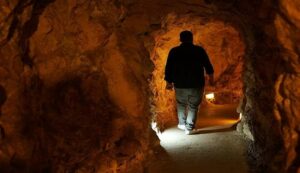Israeli soldiers release one-minute video of Hezbollah’s complex tunnel in south Lebanon
Since the beginning of the Gaza War on October 7, 2023, when Hamas began attacking Israeli communities, Israel and Hezbollah have been at odds.

A “hundreds of meters long” tunnel in south Lebanon was shown in the film; it had water tanks, two-wheelers, AK-47 guns, iron doors, and “functioning” compartments.
“We are entering south Lebanon via the border to investigate Hezbollah’s activities in the communities there. The Israeli soldier is heard stating on the video, “Embedding itself underneath civilian houses preparing for an October 7-style attack on northern Israel.”
INSIDE LOOK into a Hezbollah terrorist tunnel in southern Lebanon: pic.twitter.com/h3ZastZHxC
— Israel Defense Forces (@IDF) October 15, 2024
Along with meals on the table, gold bags, clothes, equipment, and everything needed to go from this bunker to the Israeli border had been discovered by the Israeli Defense Forces (IDF).
What is the history of the Lebanon Tunnel?
The history of Hezbollah’s tunnels began in the middle of the 1980s, when Israeli forces left most of Lebanon and relocated to an occupied area near the country’s southern border.
According to Nicholas Blanford, a senior fellow at the Atlantic Council and a specialist on Hezbollah based in Beirut, “it’s been widely understood for a long time that Hezbollah has extensive tunnel networks… used to store munitions and to serve as low-signature missile (and) rocket launch pads,” AFP said.
Israel was under tremendous strain “despite its air supremacy” as a result of Hezbollah’s deployment of the tunnels during the 2006 conflict.
Experts told AFP that Hezbollah has since been constructing more intricate tunnels and subterranean infrastructure.
The Israel military said in January 2019 that it had found and demolished “cross-border attack tunnels,” some of which were buried under border communities in Lebanon and against which Israel had launched multiple attacks since October.
How Do Subterranean Tunnels Benefit Hezbollah?
Much has been written about Hezbollah’s unconventional arsenal storage strategy, which involves trucks, weapons, and rockets. According to Israeli estimates, the tunnel network stretches hundreds of kilometers, and it is essential to Hezbollah’s capacity to change weapons, reveal operations, and evade aircraft observation. According to the US Congress assessment, they are thought to have over 150,000 missiles in their arsenal.
According to a report by Reuters, video was leaked last month that seemed to show militants from Hezbollah maneuvering vehicles equipped with rocket launchers through tunnels.
According to the French daily Liberation, which The Cradle cited, Hezbollah has a “remarkably sophisticated” tunnel network that stretches all the way to Syria.
After the battle in 2006, Hezbollah’s arsenal and tunnels have grown, Sayyed Hassan Nasrallah, the organization’s leader, has said. This includes precise guidance systems. According to Hezbollah authorities, throughout the last year, the organization has only deployed a tiny portion of its weaponry in combat.
Tal Beeri, head of Alma’s Research Department and a former IDF intelligence unit member, was questioned about how Hezbollah kept precision-guided missiles in tunnels. The Times of Israel cited Beeri as saying, “Fateh 110 [surface-to-surface ballistic] missiles are carried on trucks.” A vehicle can go to the missile firing location thanks to the underground infrastructure. Theoretically, a platform or a slope rising from the tunnel may be built at the launch point. The vehicle emerges from the tunnel, ignites, and descends once again.
Former Lebanese commander and military expert Hisham Jaber told AFP that rebels could spend months within well-stocked tunnels and that “warplanes cannot reach these facilities.”
According to Israeli authorities, Hezbollah’s military infrastructure is intricately interwoven within the southern Lebanon towns and neighborhoods, with missile launcher pads and ammo being kept in various homes. In an effort to weaken Hezbollah’s capabilities, Israel has been bombarding parts of those communities for months.
According to a 2021 study by Alma, an Israeli research organization that focuses on Hezbollah, North Korea, and Iran, it contributed to the expansion of the tunnel network after the 2006 conflict.
According to the Times of Israel, Hezbollah and Korea had been interacting for 25 years at this point. During that time, Hezbollah gained technology and information that allowed it to dig and construct the tunnels on its own.
Israel has already had difficulty expelling Hamas leaders and independent combatants from the tunnels that crisscross Gaza.
Retired Lebanese commander and military expert Hisham Jaber was reported by AFP as saying that Israel might “keep on destroying Lebanon for months without ever reaching” the bunkers. He said that “South Lebanon’s mountains and hilltops are ideal for digging (facilities) that are protected because they are at the heart of a mountain” and that the “Imad 4” facility is likely one of many dozen.
According to Reuters, Andreas Krieg, a senior professor at King’s College London’s School of Security Studies, said the tunnels in Lebanon were carved out of thick mountain rock, in contrast to Gaza, where most tunnels are physically excavated into sandy soil. “They are even harder to destroy and far less accessible than in Gaza.”
What Is Israel Capable Of?
On October 1, the IDF started conducting “limited, localized, and targeted ground raids” in southern Lebanon. On the same day, the military said that throughout the previous year, it had conducted several covert cross-border operations aimed at demolishing Hezbollah’s infrastructure.
The officer, who discussed the military’s approach while speaking on the condition of anonymity, said that the forces haven’t yet entered far into Lebanon and have instead operated from a few hundred yards to two or three kilometers within Lebanese territory.





